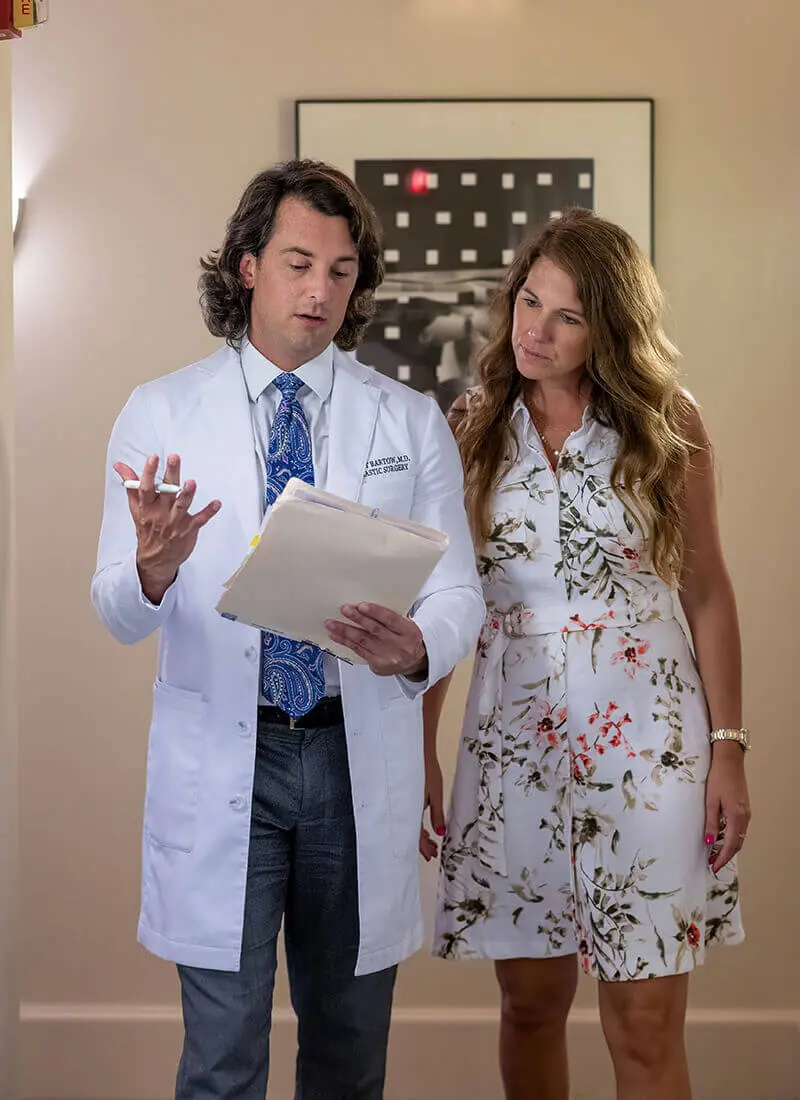
What is Breast Augmentation?
Breast augmentation, also known as augmentation mammaplasty, is a surgical procedure that uses implants to increase the size, enhance the shape, or improve the symmetry of the breasts. This highly customizable procedure offers various implant types, placements, and incision methods to achieve the desired outcome.
Breast augmentation has become increasingly popular over the years. This transformative procedure can enhance body proportions, restore volume lost after pregnancy or weight loss, and boost your confidence. With the ability to provide natural-looking results, it’s no wonder that breast augmentation consistently ranks as one of the top cosmetic surgical procedures performed annually. Whether you’re dissatisfied with the size, shape, or symmetry of your breasts or simply want to enhance your body, breast augmentation can help you achieve your aesthetic goals and feel more empowered and confident.
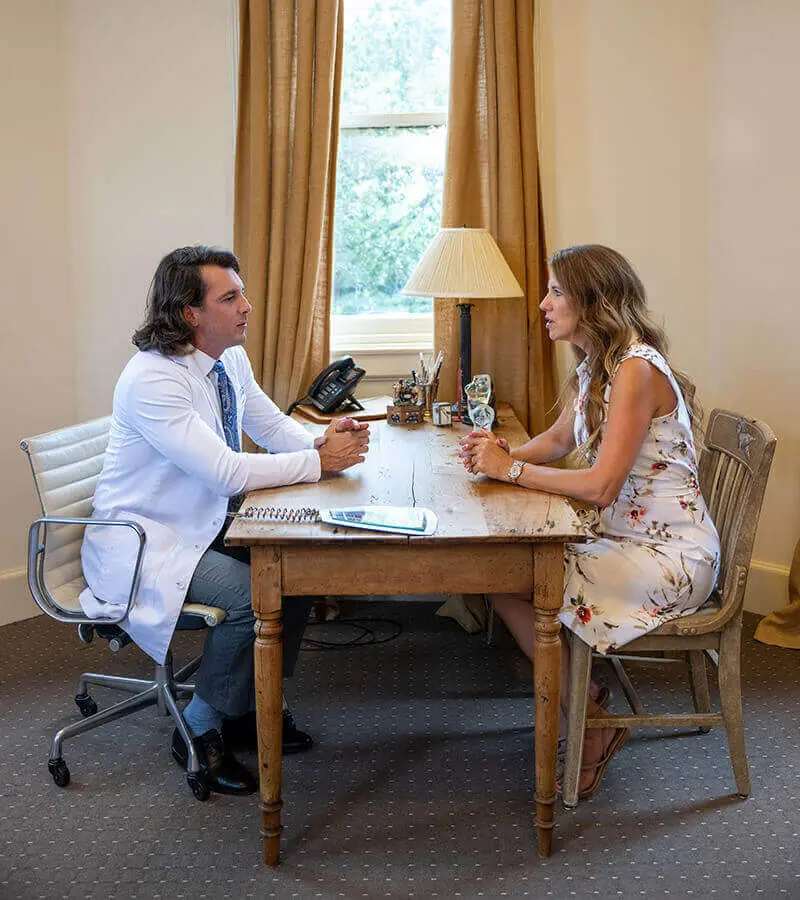
Who Is a Candidate for Breast Augmentation?
Dr. Bartow believes the Ideal candidates for breast augmentation are women who:
- Are in good overall health.
- Have fully developed breasts.
- Are dissatisfied with the size, shape, or symmetry of their breasts.
- Have realistic expectations about the outcome of the surgery.
- Are not currently pregnant or breastfeeding.
Certain medical conditions or lifestyle factors, such as smoking, may impact candidacy. It is important to discuss your medical history and goals with a plastic surgeon during your consultation.
What Are the Benefits of Breast Augmentation?
Breast augmentation offers numerous benefits, including the following:
- Enhanced breast size and shape.
- Improved body proportions and balance.
- Increased self-confidence and self-esteem.
- Restoration of breast volume lost due to aging, pregnancy, or weight loss.
- Enhanced breast symmetry.
In addition to aesthetic benefits, many women report a positive impact on their overall quality of life following breast augmentation.

What Are My Breast Augmentation Options?
Choosing the right implant is a key decision in the breast augmentation process. During your consultation Dr. Bartow will discuss in detail the differences of various implant materials.
The main types of breast implants include the following:
Saline
Saline implants are made of a silicone shell filled with a sterile saltwater (saline) solution. They are inserted empty and filled once in place, allowing for smaller incisions. Saline implants offer a uniform shape, firmness, and feel.
Silicone
Silicone implants are made of a silicone shell filled with a silicone gel. They are pre-filled, which may require a slightly larger incision. Silicone implants are known for their natural appearance and texture and closely mimic the feel of natural breast tissue.
Gummy Bear
Also known as form-stable implants, gummy bear implants are filled with a thicker silicone gel that maintains its shape even if the implant shell is broken. These implants are firmer than traditional silicone implants and are less likely to ripple.
In addition to choosing the material, you can select between round and anatomical (teardrop-shaped) implants.
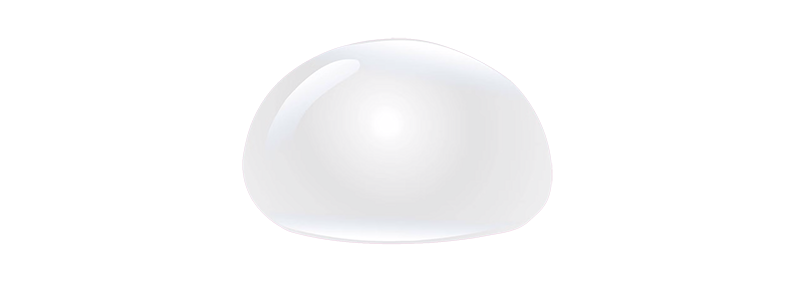
Round Implants:
Round implants provide a fuller upper pole and are often preferred for their ability to enhance cleavage.
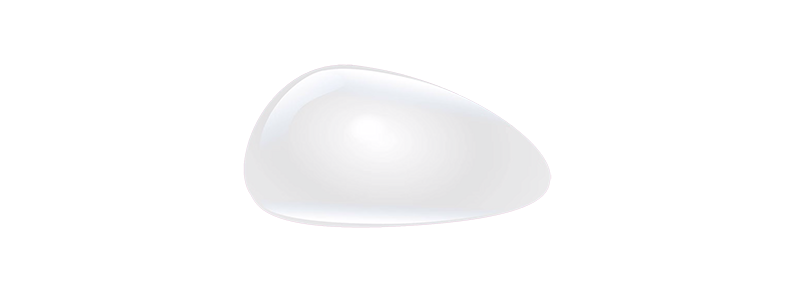
Anatomical Implants:
Anatomical (teardrop-shaped) implants offer a more natural slope and are designed to mimic the natural shape of the breast.
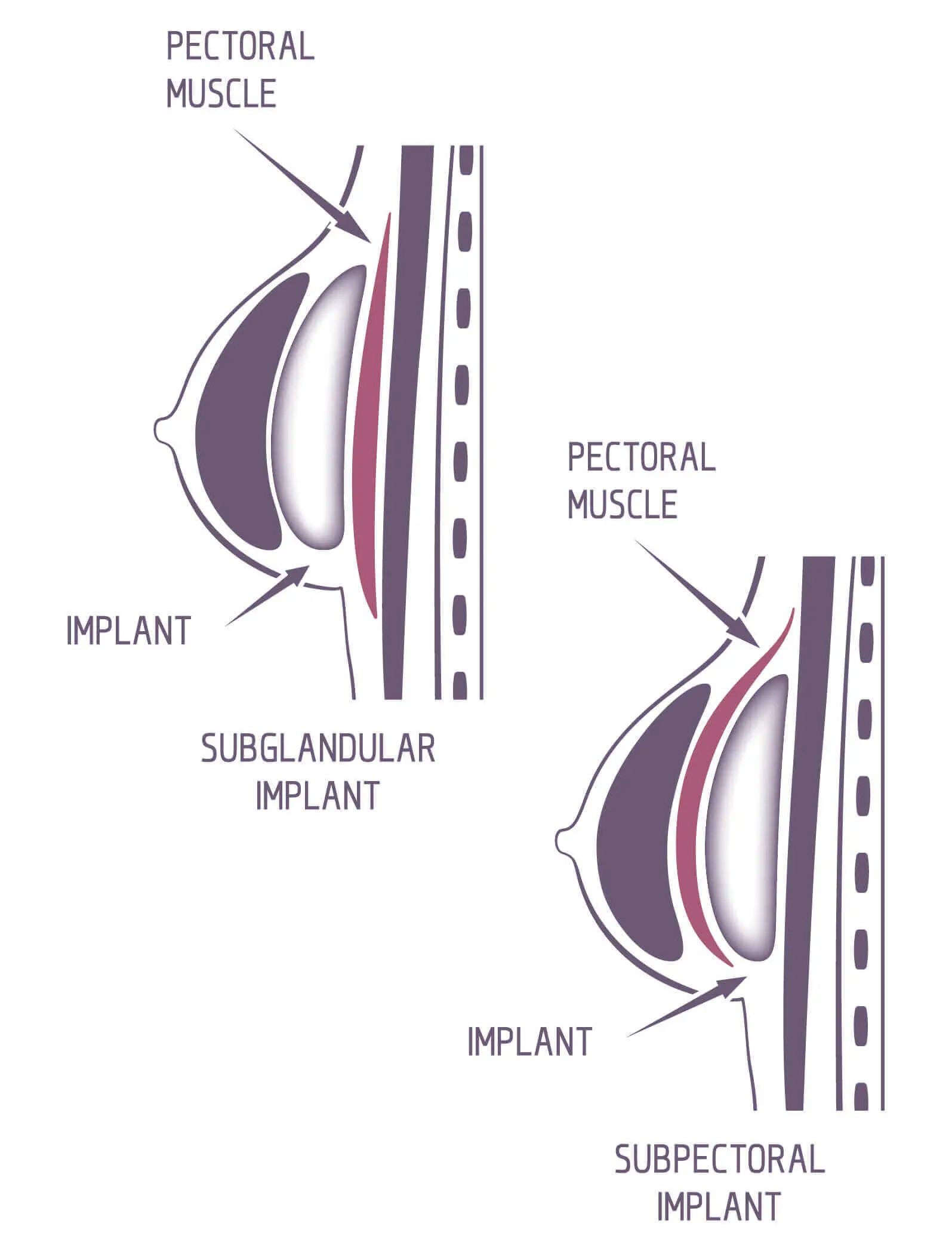
Breast Implant Placement
Breast implants can be placed in two primary positions:
Subglandular (Above the Muscle): The implant is placed directly behind the breast tissue and above the pectoral muscle. This placement can result in a quicker recovery and less postoperative discomfort. However, it may not be suitable for women with thin breast tissue as it can lead to more visible implant edges and rippling.
Submuscular (Below the Muscle): The implant is placed under the pectoral muscle. This placement often produces a more natural appearance, especially for women with less natural breast tissue. It also reduces the risk of visible rippling and capsular contracture (hardening of scar tissue around the implant). However, it may involve a longer recovery period and more postoperative discomfort.
Breast Implant Incisions
There are several incision options for breast augmentation, each with its advantages:
Inframammary Incision: The incision is made under the breast (inframammary fold). This location allows for precise implant placement and is well-concealed by the natural breast fold.
Periareolar Incision: The incision is made around the edge of the areola (the darker-colored skin surrounding the nipple). It allows for good control over implant placement and is less visible due to the natural color transition between the areola and breast skin.
Transaxillary Incision: The incision is made in the natural crease of the armpit. It leaves no scar on the breast itself and is done under guidance of an endoscope. Not all surgeons are trained in this approach however Dr. Bartow received extensive training in this technique and is excited about providing breast augmentations that leave no visible scars on the breast.
Transumbilical Breast Augmentation (TUBA): Made through a small incision in the navel, this technique is the least common and leaves no visible scars on the breast. It is technically more challenging and is typically used for saline implants.
How Is a Breast Augmentation Performed?
During your breast augmentation consultation, you and Dr. Bartow will discuss your aesthetic goals and medical history. He will conduct a physical examination, assess your breast anatomy, and discuss your breast implant options, including implant type, size, and placement and incision location. You may also try on implant sizers to visualize potential results. Dr. Bartow will also explain the surgical process, risks, recovery, and costs. Your consultation is an opportunity to ask questions and ensure all your concerns are addressed, helping you to make informed decisions about the procedure.
Preoperative InstructionsBefore your breast augmentation surgery, you will be provided with a set of preoperative instructions. These are not just guidelines, but a roadmap to a smooth surgery and recovery process. Generally, these preoperative instructions include avoiding certain medications, such as blood thinners and anti-inflammatory drugs (e.g., aspirin and ibuprofen), which can increase bleeding risks for at least two weeks before surgery. Some vitamins and supplements may also cause problems during or after surgery, so it is best to avoid them or to talk to your surgeon about potential side effects.
You should also stop smoking for several weeks before surgery to promote better healing. You will need to arrange for someone to drive you home and care for you during the first 48 hours after your procedure. Patients should also follow specific hygiene protocols, such as showering with antibacterial soap, and wear loose, comfortable clothing on the day of surgery. Following these preoperative instructions will help ensure a successful surgery and smooth recovery.
During the ProcedureBreast augmentation is typically performed as an outpatient procedure with general anesthesia and takes about two hours to complete. Dr. Bartow will make an incision and insert the implants either above or below the pectoral muscle. Once the implants are positioned the incisions will be closed and sterile bandages will be applied. Postoperative care instructions will be provided to ensure proper healing and optimal results.

What Can I Expect During Recovery From Breast Augmentation?
Recovery from breast augmentation varies from patient to patient, but it generally follows these stages:
- Immediate Postoperative Care: After surgery you will be monitored in a recovery area before being discharged. Your breasts will be covered with gauze and a supportive bra or bandage to minimize swelling and support the healing tissues.
- First Few Days: You may experience discomfort, swelling, and bruising. Pain medication and antibiotics may be prescribed to manage discomfort and prevent infection. It’s essential to rest and avoid strenuous activities during this time.
- First Few Weeks: Swelling and bruising will gradually subside. Most patients can return to work and light activities within one to two weeks but should avoid heavy lifting and vigorous exercise for at least six weeks.
- Long-term Recovery: Full recovery can take several months. To ensure optimal healing follow Dr. Bartow’s postoperative instructions regarding follow-up appointments, wound care, and activity restrictions.
When Will I See My Breast Augmentation Results?
The results of breast augmentation are typically noticeable immediately after surgery, although the final outcome will become more apparent as swelling subsides and the implants settle into their final position. This process can take several weeks to a few months. Initially, breasts may appear high and firm, but they will gradually soften and assume a more natural position over time.
Enhancing breast size and shape can significantly improve body proportions and self-confidence. Maintaining a healthy lifestyle and following your surgeon’s recommendations and postoperative instructions will ensure long-lasting results.
How Much Does Breast Augmentation Cost?
Breast augmentation costs vary widely, typically ranging from $5,000 to $10,000. According to the American Society of Plastic Surgeons, the average surgeon/physician fee for breast augmentation with implant placement (both for primary and revision surgery) in 2023 was $4,875. Factors influencing the cost include the surgeon’s experience, implant type, surgical facility fees, and geographic location. Additional expenses include anesthesia and postoperative care. You will receive an accurate cost estimate for your breast augmentation during your consultation.
FAQ About Breast Augmentation
What other procedures can be combined with breast augmentation?
Many women choose to combine breast augmentation with other cosmetic procedures for a more comprehensive transformation. Commonly combined procedures include:
Breast Lift (Mastopexy): This procedure raises and firms the breasts by removing excess skin and tightening the surrounding tissue. This combination is ideal for women seeking both volume and lift.
Liposuction: This procedure removes excess fat from various body areas, enhancing overall body contour.
Tummy Tuck (Abdominoplasty): This procedure removes excess skin and fat from the abdomen and tightens the abdominal muscles for a flatter, more toned appearance.
Mommy Makeover: This surgery combines multiple procedures to restore a woman’s pre-pregnancy body, typically including breast augmentation, breast lift, tummy tuck, and liposuction.
Is breast augmentation painful?
Breast augmentation involves some pain and discomfort, particularly in the first few days following surgery. Pain levels vary among individuals, but most patients describe it as manageable with prescribed pain medications. Swelling, bruising, and tightness are common and gradually subside over a few weeks. Following your surgeon’s postoperative care instructions can help minimize discomfort and promote a smoother recovery.
Does breast augmentation leave scars?
Although breast augmentation causes scars where the incisions are made, they are typically small and strategically placed to be as inconspicuous as possible.
Common incision sites include the inframammary fold, around the areola, or in the armpit, all of which help to conceal scars. Over time, scars usually fade and become less noticeable. Proper postoperative care, including scar treatments recommended by Dr. Bartow, can further minimize their appearance.
What are the risks associated with breast augmentation?
Like any surgical procedure breast augmentation carries risks and potential complications. Common risks include the following:
- Infection
- Bleeding
- Adverse reactions to anesthesia
- Capsular contracture (scar tissue that forms tightly around the implant, causing pain and distortion)
- Implant rupture or leakage
- Changes in nipple or breast sensation (can be temporary or permanent)
- Implant displacement
- Asymmetry
- Dissatisfaction with aesthetic outcomes
- Blood clots or deep vein thrombosis (rare but serious)
Discussing all potential risks with your surgeon during your consultation will help set realistic expectations. Following all your surgeon’s preoperative and postoperative instructions will reduce your risk for these complications. Regular follow-up appointments are essential for monitoring complications and timely intervention.
How do I choose the right size of breast implants?
Choosing the right size of breast implants involves considering your body proportions, aesthetic goals, and lifestyle. Consult with a plastic surgeon to evaluate your breast anatomy and skin elasticity. Using implant sizers during the consultation can help you visualize different sizes. Discuss your desired outcome and any concerns with your surgeon, who will guide you in selecting a size that complements your natural body shape and achieves a balanced, proportionate look. Remember, the right size should enhance your figure while maintaining a natural appearance and complementing your overall physique.
Will my breast implants look natural?
Breast implants can look natural when the right implant type, size, and placement are chosen. Advances in implant technology, such as silicone and gummy bear implants, offer a natural feel and appearance. The skill and experience of the surgeon also play a crucial role in achieving a natural look. Discussing your aesthetic goals and undergoing a thorough consultation with a plastic surgeon can help ensure that your implants complement your body shape and look as natural as possible.
How long do breast implants last?
The longevity of breast augmentation results varies. Although breast implants are not lifetime devices, they typically last 10–20 years. Factors such as aging, weight fluctuations, pregnancy, and hormonal changes can affect the appearance of augmented breasts over time. Regular monitoring and follow-up appointments with your plastic surgeon are essential to ensure the implants remain in good condition and address any potential issues.
Will breast augmentation affect my ability to breastfeed?
Many women can successfully breastfeed after breast augmentation, but it can vary depending on the type of surgery and implant placement. Incisions around the areola may pose a higher risk to milk ducts and nerves. Discuss your breastfeeding goals with your surgeon to choose the best surgical approach for preserving your ability to breastfeed.
Are there alternatives to breast implants for augmentation?
Alternatives to breast implants for enhancement include fat transfer breast augmentation, where fat is harvested from another part of the body and injected into the breasts. This method offers a more natural look and feel without the risk of implant-related complications. However, it may provide a more modest increase in breast size compared to implants.
